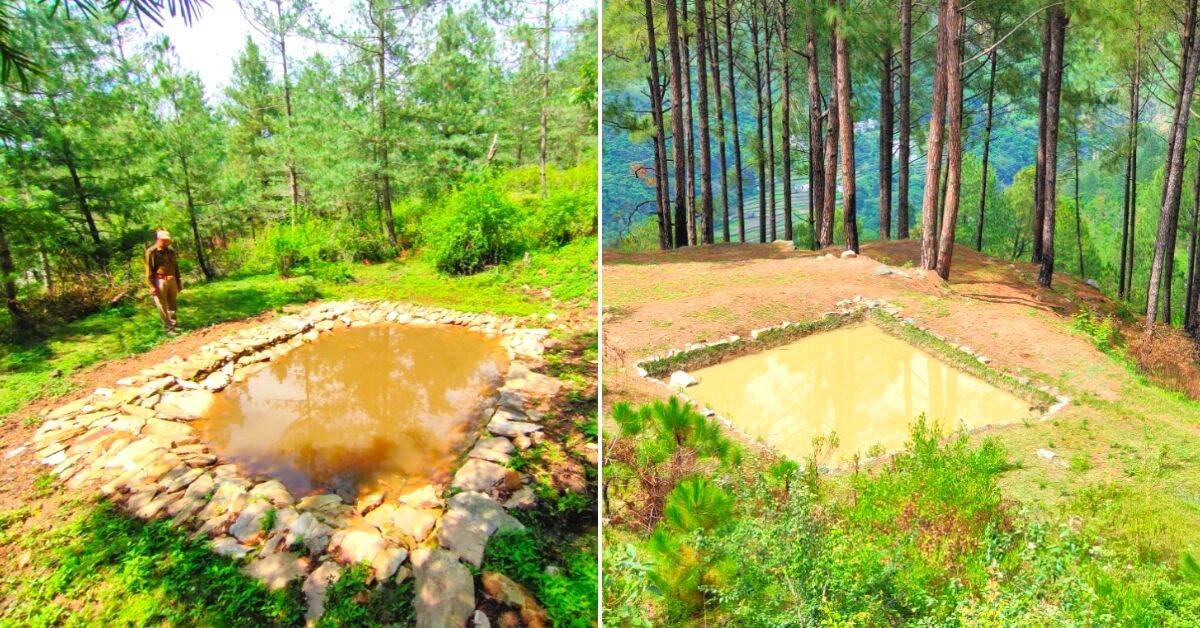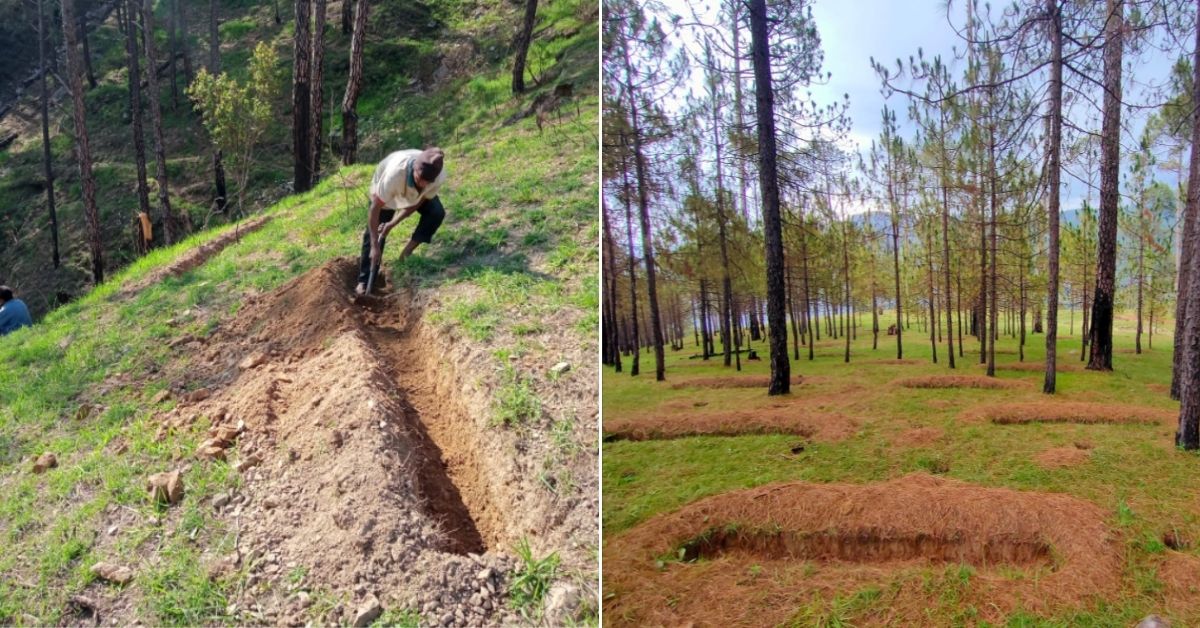How an IFS Officer Helped Rudraprayag Harvest Over 10 Million Litres of Rainwater
The DFO of Rudraprayag in Uttarakhand, IFS officer Vaibhav Singh has set an inspiring example of conservation by restoring Himalayan forests and harvesting over 10 million litres of rainwater.

Located in the middle Himalayan belt of Uttarakhand, the forests of Rudraprayag district lie in altitudes ranging from around 800 metres to 3,000 metres above sea level. Nearly 70% of the forest, however, lies between 1,000 and 2,000 metres above sea level. These forests are susceptible to a variety of natural disasters, including forest fires and landslides, while shortages in fresh water supply to local communities is a key concern.
“Nearly half the forests in Rudraprayag are dominated by pine trees, which makes them susceptible to forest fires. The lack of soil moisture and rich vegetation create ideal conditions for forest fires in the event of high temperatures. As soon as you have heavy rains, the same forests become vulnerable to landslides. In pine-dominated forests, the soil thickness is very less. There is very little topsoil, which is why only pine trees dominate the landscape. During these unpredictable rainfall events, a lot of top soil and debris get washed away. This takes away all the nutrients and adds to the discharge of rivers below, leading to silting, flooding and other problems,” says Vaibhav Singh, a 2015-batch Indian Forest Service officer and Divisional Forest Officer (DFO) at Rudraprayag, Uttarakhand.
There is also the problem of supplying fresh water to rural communities. Villages situated in the region get their water supply from nearby springs and water sources lying inside the forest. Since most of the middle Himalayan belt is in a dry region, over the past few years, locals have been complaining about water shortages. They often complain about the springs drying up and no proper supply of water during summers. Most residents of these villages are women and senior citizens since most working men from there find employment elsewhere. The women are into livestock rearing, and thus dependent on forests for fodder.
“Since my tenure in Rudraprayag began, we started doing soil moisture conservation work extensively and on a planned basis. We were lucky to obtain funds from the State Compensatory Afforestation Fund Management and Planning Authority (CAMPA), while rainwater conservation and harvesting is a priority area for the government both at the Central and State level. With the funds available, we decided to construct as many water retention and soil preserving structures that have multiple benefits,” he adds.
Since Vaibhav took over as DFO in June 2019, there has been a strong emphasis on addressing these problems by building soil moisture conservation (SMC) structures which include Chal Kahls (‘water ponds’ in Garhwali), contour trenches, check dams, and percolation pits, among other such structures, in an organised and planned manner.
In the past year alone, Vaibhav and his forest staff have constructed a total of 612 Chal Kahls with a total water holding capacity of more than 10 million litres while also eco-restoring over 400 hectares of degraded forest land.
Over the course of two years, however, they have reportedly constructed 887 Chal Kahls with each structure having a water holding capacity ranging from 10,000 to 2,50,000 litres.
During the monsoon season and the winter rains from October to December, these structures trap significant volumes of rainwater. This water improves the microclimate of the soil and adds to the soil moisture.

Location, Location, Location
The process of making these ponds start before the monsoon season from May onwards. The forest staff start digging these structures in May and continue to make them as and when funds from the government are available. They try to complete a majority of these structures before the monsoon and winter rains. The most critical part of constructing these ponds is site selection to ensure their effectiveness. The field staff, including forest guards, forest watchers and range officers who select the site, need to be properly sensitised, trained and monitored. Constructing these structures at the proper site, Vaibhav notes, is the biggest challenge.
“If we select the right sites, 50% of our job is done. We have to gauge the gradient of the slope, the place, the rock structure present, the location where you intend to make that pond and its utility in a given area. If you construct these ponds at the wrong site, then the drainage water might not even get collected there. If you’ve chosen the wrong slope, the structure won’t be most effective. To channelise the excess water into these ponds from these slopes, we also dig these small trenches. If you construct Chal Kahls on a very steep slope, the velocity of the water may damage or wash them away. All these water ponds vary in their size and capacity. The smallest ponds we make is of 10 cubic metres of dug up soil, which amounts to roughly 10,000 litres of water holding capacity. Most of the ponds we’ve constructed have a water holding capacity between 10,000 and 20,000 litres,” he explains.
Increasing soil moisture in a given area not only aids the growth of other vegetation but also reduces the vulnerability to forest fires. Moreover, there are about 70 water supply projects managed by the Uttarakhand Jal Sansthan, a department overseeing water supply, irrigation and sewerage in rural and urban areas in Rudraprayag division that channelise water from the water springs and other bodies into villages. Constructing structures like Chal Kahls has rejuvenated these springs and increased the discharge of water and groundwater percolation.
To supplement these efforts, the forest department has constructed contour trenches along 436 hectares of degraded pine forests over the past two years. They also planted some suitable grasses for fodder on the edges. When water gets trapped in these trenches, the fodder grass derives moisture from it and starts growing. This is beneficial for local communities because their livestock gets access to more fodder. It’s beneficial for the department because the micro-climate within the forests improves.

“Contour trenches trap rainwater and top fertile soil during rainfall and improve the microclimate which further promotes a diversity of vegetation. To further add to the efficacy of trenches, napier and other fodder grass slips were planted along the trenches. During the monsoons, the grass derives moisture from the water trapped in trenches and grows extensively. It provides fodder to the livestock of locals as well as wildlife. These structures arrest the erosion of soil. In digging contour trenches, we’ve seen that in almost 1.5 to 2 years, they get filled with silt and top soil. These structures are beneficial for conservation of soil, which is a precious resource in this part of Uttarakhand,” explains Vaibhav.
Structures like contour trenches, water ponds, and percolation pits will, over the long term, further supplement aquifers and rejuvenate natural water springs. “But, there is a 15% to 20% margin of error in choosing good sites,” he adds.

Thankfully, under DFO Singh’s tenure, the relationship between locals and the forest department has improved, which has an impact on site selection.
“Most of our forest staff are also from the same communities. They maintain strong informal channels of communication with the local residents. On many occasions, locals also give us feedback about where to build these SMCs,” claims Vaibhav.
An Officer’s ‘Untiring Support’
“The great thing about DFO Singh’s work is the fantastic planning that goes behind it. More importantly, he has been able to establish a good relationship between the forest department and local communities, which was once tenuous. I’ve done multiple ground reports on these initiatives, and there is no question that he has done great work in the division,” says Vinay Bahuguna, a local journalist for Amar Ujala, a popular Hindi daily newspaper.
Just before the monsoon started last year, the forest staff constructed many check dams in three locations, which the DFO went and visited during and after the monsoons.
“When the rains came, the upper catchment area of the hillock got washed away. There was a lot of debris, boulders and they were all stopped from crashing down thanks to these check dams. In these check dams, we also saw huge quantities of fertile soil that were stopped from being washed. We make a lot of vegetative check dams, particularly pirul (pine needle) check dams. Again, site selection is crucial here. In small valleys with not very high gradients, we cut tree logs, tie them up and stuff them with pine needles and rocks, which stops the flow of water. If it’s a very steep gradient, you have to make a crate wire check dam. If you make a loose boulder check dam here, it’ll simply get washed away. When the gradient is gentle, the width of the drain is not very wide, you can make a small rock and boulder check dam. We start scanning areas from higher altitudes and then proceed downwards. In total we’ve constructed 1,892 check dams which include crate wire check dams, vegetative check dams and dry stone check dams,” he claims.

Despite all the achievements in the past two years, there have been a few stiff challenges along the way. The biggest one is the “extreme shortage” of labour. Although the pandemic has brought some relief to this aspect, given that many have come back to their villages after losing work in the cities, the department depends primarily on seasonal Nepali labourers. Another challenge, he says, is that most of the forest staff working under the DFO are above the age of 45 and canvassing for sites to build SMC structures is an onerous task.
Funding for these initiatives, meanwhile, come from three key sources—State CAMPA funds, Forest Fire Prevention and Management (FPM) scheme, under which some of the soil moisture conservation works are done, and the Union government’s Namami Gange Programme, which facilitates a certain amount of check dam construction work.
The impact of the forest department’s work, however, has been felt on the ground.
As Yashwant Singh Chauhan, a Range Officer with the Agastmuni Block in Rudraprayag district, explains, “A couple of days back, the temperature here was 44° Celsius but you wouldn’t know whether it rained or not because there is so much moisture in the soil. Also, there is a village called Bhausal and in the surrounding area, we’ve constructed a Chal Kahl. The Dhara (spring emerging where sloping ground and impermeable strata intersect with the groundwater table) above the village has been recharged thanks to the Chal Kahl we’ve constructed there.”
He adds, “The impact of whatever works we do in forestry is not often seen immediately. It’s like afforestation work to regenerate the forest. The real results will be seen only years later.”
Meanwhile, the forest department has also gone on to undo some of the wrongs done in the past like concretising a small lake near a quiet hamlet called Chirbatiya.
“This concrete work was done about 10 to 15 years ago in the name of beautification, which I found had killed the lake. An oval-shaped concrete base was constructed inside a lake with further concrete fencing around it. It had become an artificial water tank because all its ecological value was eradicated. We broke it down and did a lot of dredging work in the surrounding areas. There was also an encroachment with the owner of the structure bringing tourists there, whom we evicted. The lake is now taking its natural shape,” says Vaibhav.
In the coming year, the Forest Department will work alongside the Uttarakhand Jal Sansthan for the 70 water supply projects. “We will be working in the catchment area of 25 of those projects. We have submitted our proposal for funds. That way in the next three years, we can monitor whether the work we are doing is actually having a significant bearing on the discharge of the springs and water supply streams,” he says.
The bottomline remains that DFO Vaibhav Singh has led by example to revive these forests in Rudraprayag, protect them from forest fires, preserve the precious topsoil and deliver fresh water to locals.
As Yashwant says, “DFO Sir has taken a real interest in these soil and water conservation efforts since his arrival here. Subordinate forest officers and staff will work well if the person at the top takes interest. He has always backed our efforts with his untiring support. In the past year, we’ve managed to get a lot of work done.”
(Edited by Yoshita Rao)
Like this story? Or have something to share? Write to us: [email protected], or connect with us on Facebook and Twitter.

Similar Story

Ex-IRS Officer’s Free UPSC CSE Course Eliminates Need for Paid Coaching
An IRS officer-turned-educator, Ravi Kapoor has mentored thousands of UPSC aspirants for free. Taking upon his 10 years of bureaucratic experience and masters in clinical psychology, Ravi’s approach to UPSC mentorship has always kept mental fitness and motivation in focus.
Read more >
If you found our stories insightful, informative, or even just enjoyable, we invite you to consider making a voluntary payment to support the work we do at The Better India. Your contribution helps us continue producing quality content that educates, inspires, and drives positive change.
Choose one of the payment options below for your contribution-
By paying for the stories you value, you directly contribute to sustaining our efforts focused on making a difference in the world. Together, let's ensure that impactful stories continue to be told and shared, enriching lives and communities alike.
Thank you for your support. Here are some frequently asked questions you might find helpful to know why you are contributing?


This story made me
-
97
-
121
-
89
-
167












